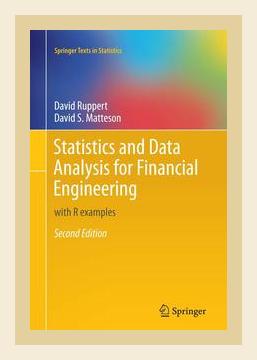Finance, Economics, Trading, InvestingQuantitative Finance and Risk Management
Introduction
“Statistics and Data Analysis for Financial Engineering” by David Ruppert is a seminal text that blends statistical theory with practical applications in financial engineering. The book addresses the increasing demand for financial engineers to possess a robust understanding of statistical methods, providing them with the necessary tools to analyze financial data effectively. This comprehensive guide not only delves into the theory behind statistical models but also demonstrates their real-world applications in finance, making it an essential resource for both students and professionals. Whether you’re a seasoned financial analyst or a student venturing into the world of finance, this book offers valuable insights into the statistical methodologies that drive modern financial engineering.
Overview of the Book
1. Foundations of Probability and Statistics
The book begins by establishing the fundamental concepts of probability and statistics, which are crucial for understanding more advanced topics later on. Ruppert emphasizes the importance of these concepts in financial modeling, laying a strong foundation with clear explanations and practical examples.
- Key Concepts: The section covers essential topics such as random variables, probability distributions, expected value, and variance. Ruppert also introduces readers to the central limit theorem, a critical concept in statistical analysis.
- Example: A notable example in this section is the application of the normal distribution in modeling asset returns. Ruppert illustrates how financial engineers can use this distribution to estimate the probability of extreme events, such as market crashes.
Memorable Quote: “In financial engineering, understanding the behavior of asset returns is paramount, and probability distributions are the tools that allow us to quantify this uncertainty.”
2. Regression Analysis
Regression analysis is a cornerstone of financial modeling, and Ruppert dedicates an entire section to this powerful statistical technique. He covers both simple and multiple regression, discussing their applications in finance.
- Key Concepts: The author explains how to build regression models to predict asset prices, evaluate investment strategies, and assess risk. He also delves into the assumptions underlying regression models and how to diagnose potential issues such as multicollinearity and heteroscedasticity.
- Example: An example provided is the use of regression analysis to model the relationship between interest rates and bond prices. Ruppert demonstrates how a financial engineer might use this model to predict future bond prices based on expected changes in interest rates.
Memorable Quote: “Regression analysis is not just about fitting a line to data; it’s about uncovering relationships that can drive financial decisions.”
3. Time Series Analysis
Time series analysis is particularly relevant in finance, where data points are often sequential and time-dependent. Ruppert introduces readers to the key concepts and techniques used to analyze financial time series data.
- Key Concepts: The section covers autoregressive models (AR), moving averages (MA), and ARIMA models, which are commonly used to forecast economic indicators, stock prices, and interest rates. Ruppert also discusses the importance of stationarity in time series analysis and how to transform non-stationary data.
- Example: A practical example in this section is the use of ARIMA models to forecast stock prices. Ruppert guides readers through the process of selecting the appropriate model, estimating its parameters, and validating the model’s accuracy.
Memorable Quote: “In financial markets, the past is often prologue; time series analysis allows us to leverage historical data to anticipate future trends.”
4. Portfolio Theory and Risk Management
This section bridges the gap between statistical analysis and financial decision-making by exploring portfolio theory and risk management. Ruppert discusses how statistical tools can be used to optimize portfolios and manage financial risk.
- Key Concepts: The author introduces the concept of the efficient frontier, where investors can achieve the best possible return for a given level of risk. He also explains how to use statistical measures such as Value at Risk (VaR) and Conditional Value at Risk (CVaR) to assess and manage portfolio risk.
- Example: An illustrative example is the use of mean-variance optimization to construct a diversified portfolio. Ruppert shows how investors can use historical return data to estimate the expected return and risk of a portfolio and then select the portfolio that maximizes return for a given level of risk.
Memorable Quote: “Risk is an inherent part of investing, but with the right tools, we can manage it in a way that aligns with our financial goals.”
5. Advanced Topics: GARCH Models and Copulas
In the latter part of the book, Ruppert introduces more advanced topics that are essential for financial engineers working with complex financial instruments.
- Key Concepts: The section covers Generalized Autoregressive Conditional Heteroskedasticity (GARCH) models, which are used to model and forecast volatility. Ruppert also explores copulas, which are used to model dependencies between multiple financial variables, such as the joint distribution of asset returns.
- Example: A notable example is the application of GARCH models in estimating the volatility of options prices. Ruppert explains how financial engineers can use these models to forecast volatility, a critical input in the pricing of options and other derivatives.
Memorable Quote: “In finance, volatility is not just a measure of risk; it’s a tradable asset, and understanding its dynamics is key to mastering financial engineering.”
Conclusion
“Statistics and Data Analysis for Financial Engineering” by David Ruppert is more than just a textbook; it’s a comprehensive guide that bridges the gap between theoretical statistics and practical financial applications. The book’s clear explanations, coupled with real-world examples, make it an invaluable resource for anyone looking to deepen their understanding of financial engineering. Whether you’re a student, a financial analyst, or a seasoned professional, Ruppert’s work provides the tools and insights needed to navigate the complex world of finance with confidence.
Ruppert’s book has been widely praised for its clarity and relevance, making it a staple in the education of financial engineers. As the field of financial engineering continues to evolve, the statistical methods and models presented in this book will remain essential for understanding and navigating the financial markets.
Finance, Economics, Trading, InvestingQuantitative Finance and Risk Management
